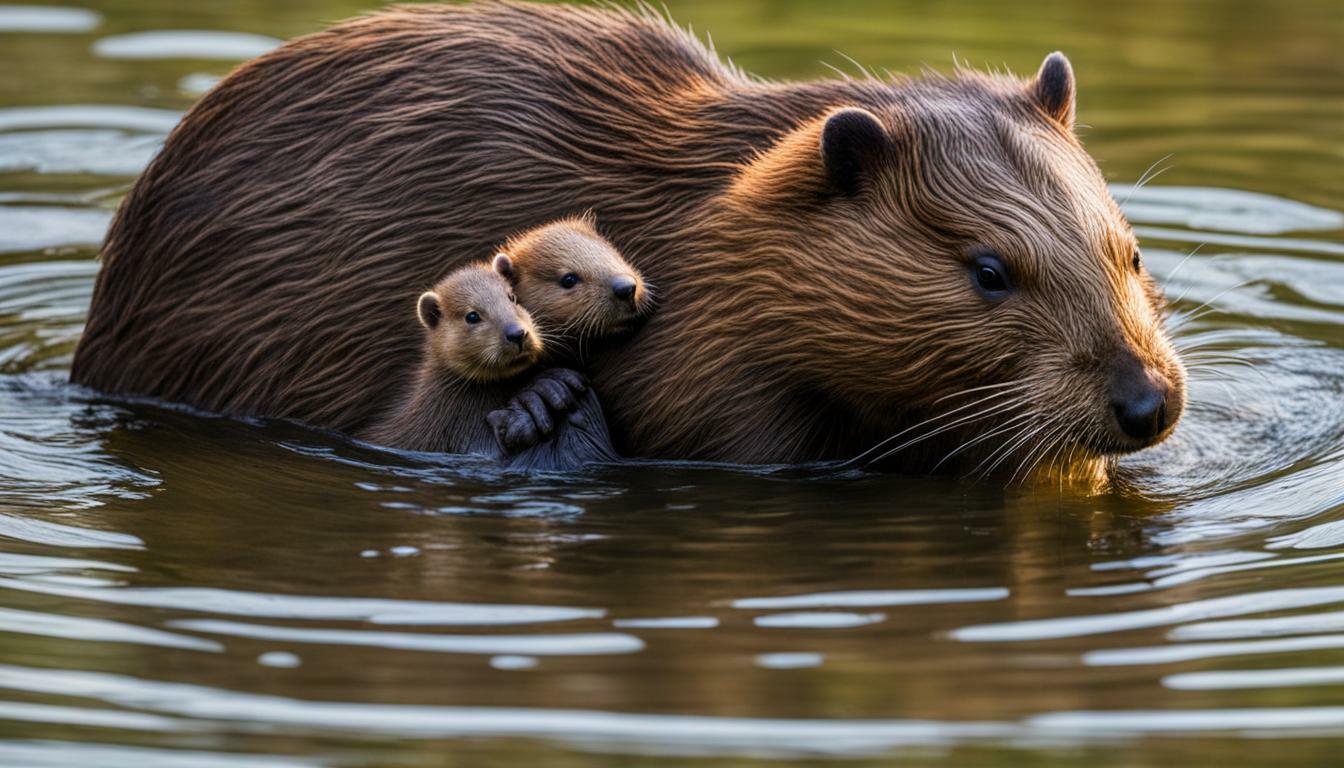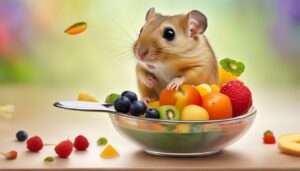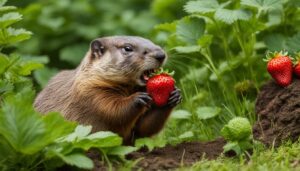Beavers have an intriguing way of carrying their young that sets them apart from most other mother animals. Instead of relying on their offspring to keep up, beaver parents physically cradle their kits and carry them around. This unique behavior showcases the remarkable parenting methods of these amazing creatures.
Key Takeaways:
- Beavers carry their young by cradling them in their arms.
- Young beavers, or kits, are born highly developed and can start swimming immediately.
- Beaver kits stay in or around the lodge for the first month, learning from their parents and older siblings.
- Beavers are monogamous animals, and kits live with their parents and siblings for several years.
- Kits have physical adaptations like webbed feet, a paddle-like tail, and translucent eyelids for swimming and evading predators.
Now, let’s delve deeper into the fascinating world of beaver parenting methods and discover how these amazing creatures care for their young.
The Cradling Behavior of Beavers
Beavers cradle their young in their arms, a behavior that is not commonly seen in other animals. This unique parenting behavior allows the beaver kits, or young beavers, to be safely transported by their parents. The adult beavers use their strong front legs to hold the kits against their chest, creating a secure and protective carrying position. Imagine a beaver parent gently walking around, their adorable kit nestled in their arms, as they go about their daily activities.
But why do beavers carry their young this way? It’s believed that the cradling behavior helps protect the kits from potential dangers, such as predators or rough terrain. By keeping the kits close, the parents can ensure their safety and provide constant care and attention. It’s truly a heartwarming sight to witness these furry creatures displaying such tenderness and devotion towards their offspring.
As for the kits themselves, they are born highly developed physically. Unlike many other species, beaver kits are capable of swimming from the moment they enter the world. Their strong instinctual abilities allow them to navigate the waterways with ease, which is crucial for their survival. While they spend the first month of their lives in or around the beaver lodge, they quickly learn from their parents and older siblings, acquiring the necessary skills and knowledge to thrive in their environment.
The Remarkable Adaptations of Beaver Kits
In addition to their remarkable cradling behavior, beaver kits possess physical adaptations that aid in their movement and survival. Their webbed feet enable them to swim efficiently, propelling themselves through the water with agility and speed. The kits also have a paddle-like tail, which acts as a rudder, helping them maintain stability and maneuverability while swimming.
One fascinating adaptation of beaver kits is their translucent eyelids. These special eyelids allow the kits to see underwater, protecting their eyes from the harsh elements while still allowing them to navigate their aquatic surroundings effectively. These adaptations, combined with their parents’ guidance and care, ensure that the kits have a strong foundation for a successful future as they grow and eventually leave the colony to start their own families.
| Fascinating Facts about Beaver Kits | |
|---|---|
| 1. | Beaver kits are born with a full set of teeth, allowing them to start gnawing on wood immediately. This helps strengthen their jaw muscles and prepares them for their role in building and maintaining their future lodges. |
| 2. | Like their parents, beaver kits use their powerful tails to communicate. They slap their tails against the water to signal danger or alert their family members to their presence. |
| 3. | Beaver kits learn to groom themselves from a young age. They spread a waterproof substance called castoreum over their fur to keep it clean and provide insulation when swimming in cold water. |
Highly Developed Newborn Beavers
Newborn beavers are highly developed and can start swimming on the day they are born. Unlike many other animal species, beaver kits are born with the ability to move and navigate through the water with ease. This remarkable physical development allows them to adapt quickly to their watery environment.
Within the first month of their lives, beaver kits primarily stay in or around the lodge. During this time, they learn essential survival skills from their parents and older siblings. Observing and imitating their family members, the young beavers gradually acquire the necessary knowledge and techniques for swimming, diving, and foraging.
Beavers are known for their monogamous nature, and the kits live together with their parents and siblings for several years before venturing out to establish their own families. This extended period of cohabitation enables the young beavers to refine their skills and learn valuable lessons from their experienced relatives.
| Physical Adaptations | Function |
|---|---|
| Webbed Feet | Aid in swimming and maneuvering through the water. |
| Paddle-like Tail | Acts as a rudder, providing balance and control while swimming. |
| Translucent Eyelids | Allow for clear vision underwater, helping to spot potential threats. |
These physical adaptations further enhance the survival chances of the young beavers. With their webbed feet, they can swiftly paddle through the water, while their paddle-like tail assists in maintaining stability and directional control. The translucent eyelids enable them to see clearly underwater, allowing them to spot predators and navigate their surroundings effectively.
Young Beaver Transportation Techniques
As the beaver kits grow older and gain more independence, they start to explore the surrounding areas beyond the lodge. They use a combination of swimming and walking to move around, utilizing their effective transportation techniques to navigate both water and land. This versatility in movement ensures that young beavers can adapt to different environments and find suitable resources for survival.
Lodge Life for Beaver Kits
Beaver kits spend the first month of their lives in or around the lodge, learning from their parents and older siblings. This period of lodge life is crucial for their development and survival.
Within the lodge, beaver kits observe and imitate their parents, picking up essential skills and behaviors. They learn how to build and maintain dams, construct lodges, and forage for food. These lessons not only prepare them for their future roles within the colony but also strengthen the bonds within the family unit.
During this time, beaver kits also socialize with their older siblings, engaging in playful activities that enhance their physical abilities. They learn valuable lessons in cooperation, communication, and problem-solving, which will serve them well as they navigate the challenges of life outside the lodge.
| Benefits of Lodge Life for Beaver Kits: |
|---|
| 1. Skill Development: Kits learn essential survival skills from their parents and older siblings. |
| 2. Bonding: Lodge life strengthens the familial bonds within the beaver colony. |
| 3. Play and Practice: Kits engage in playful activities that enhance their physical abilities and problem-solving skills. |
As the kits grow and develop, they become independent and eventually leave the lodge to establish their own families. However, the lessons learned during their time in the lodge will stay with them, shaping their behavior and ensuring the continuity of beaver family dynamics for generations to come.
Monogamous Beaver Families
Beavers form monogamous family units, with the kits staying with their parents and siblings as they grow. This strong family dynamic plays a vital role in the upbringing and survival of the young beavers. From the moment they are born, the kits are nurtured and cared for by both parents, who work together to provide for their offspring.
In the early stages of their lives, the kits learn important skills and behaviors from their parents and older siblings. They observe how their parents construct dams and lodges, forage for food, and navigate the aquatic environment. This learning process helps them develop the necessary abilities to survive and thrive in their natural habitat.
As the kits mature, they become active participants in the family unit, assisting their parents in maintaining and expanding their territory. They help with the construction of dams and lodges, gather food, and contribute to the overall well-being of the colony. This cooperative behavior within the family unit ensures the successful continuity of the beaver population.
The Sibling Bond Among Beaver Kits
The bond between siblings is particularly strong among beaver kits. They rely on each other for companionship, protection, and learning. Siblings engage in social activities, such as grooming, playing, and communication through vocalizations and tail slapping, which helps strengthen their bond and ensures their collective safety.
As they grow, older siblings often assist their parents in caring for and teaching the younger kits. This sibling cooperation not only reinforces the family unit but also contributes to the survival and success of the entire beaver colony.
Through their monogamous family structure and parenting behaviors, beavers demonstrate the importance of strong family bonds in the animal kingdom. Their commitment to their young and the collective efforts of the family unit ensure the continued survival and prosperity of these incredible creatures.
Table: Monogamous Beaver Families
| Key Points | Details |
|---|---|
| Family Structure | Monogamous pairs consisting of a male and female beaver. |
| Kits’ Involvement | Kits stay with their parents and siblings as they grow, actively participating in family activities. |
| Learning from Older Siblings | Youthful beavers observe and learn from their older siblings, acquiring essential skills and behaviors. |
| Sibling Bond | Beaver kits develop a strong bond with their siblings, engaging in social activities and supporting each other. |
| Cooperative Behavior | Family members work together to construct and maintain dams, lodges, and forage for food. |
Physical Adaptations for Survival
Beaver kits possess various physical adaptations that help them navigate their aquatic environment and avoid potential threats. These adaptations include webbed feet, a paddle-like tail, and translucent eyelids, which are unique to their species.
The webbed feet of beaver kits enable them to swim with ease and precision. This adaptation allows them to move swiftly through the water, whether it be in rivers, lakes, or ponds. The webbing also aids in their ability to construct dams and lodges, as they can easily manipulate sticks and mud with their dexterous paws.
Another remarkable adaptation of beaver kits is their paddle-like tail. This flat and wide tail serves multiple purposes. It acts as a rudder when swimming, providing stability and control. The tail also helps the kits to slap the water, creating a loud warning sound to alert other beavers of potential danger. Additionally, the tail functions as a fat storage reserve, providing the kits with an energy source during the winter months when food is scarce.
Furthermore, beaver kits have translucent eyelids, allowing them to see clearly underwater. This adaptation enables them to locate food sources, evade predators, and navigate their surroundings effectively. The translucent eyelids also protect their eyes from debris and water pressure while swimming. This remarkable feature ensures that beaver kits can thrive in their aquatic habitat.
| Physical Adaptations | Function |
|---|---|
| Webbed feet | Aids in swimming and construction |
| Paddle-like tail | Provides stability, warning signal, and fat storage |
| Translucent eyelids | Allows for clear vision underwater and protects the eyes |
These physical adaptations of beaver kits highlight the remarkable abilities and resilience of these young animals. With their webbed feet, paddle-like tail, and translucent eyelids, they are well-equipped to navigate their aquatic environment and thrive in the presence of potential threats.
Building on Previous Generations
Beaver kits learn essential skills and behaviors from their parents and older siblings, allowing them to thrive and contribute to the overall success of the colony. This process of learning from previous generations is crucial for their survival and plays a vital role in shaping their behavior.
Observational Learning
One of the primary ways in which beaver kits acquire knowledge is through observational learning. They closely watch their parents and older siblings as they engage in activities such as building dams and lodges, foraging for food, and navigating waterways. By observing these behaviors, the kits gain valuable insights into how to effectively carry out these tasks themselves.
This learning process is not only limited to practical skills but also extends to social interactions within the colony. The kits observe how their parents communicate, establish territories, and care for one another. Through these observations, they learn the importance of cooperation and the dynamics of maintaining a cohesive family unit.
| Benefits of Observational Learning for Beaver Kits: |
|---|
| Acquiring practical skills |
| Understanding social dynamics |
| Promoting cohesion within the colony |
Imitative Learning
In addition to observational learning, beaver kits also engage in imitative learning. They actively mimic the behaviors they observe, practicing them until they can perform them proficiently. This process helps them refine their skills and ensures that they can effectively contribute to the survival and well-being of the entire colony.
During the imitative learning process, the kits may receive guidance and feedback from their parents and older siblings. This interaction further enhances their understanding of the tasks at hand and allows them to make adjustments and improvements as they progress.
Passing on Knowledge
As the kits mature and become parents themselves, they contribute to the intergenerational transfer of knowledge within the colony. They pass down the skills and behaviors they acquired from their parents, ensuring that future generations continue to benefit from the collective wisdom of the colony.
Through the ongoing process of building on previous generations, beaver kits are equipped with the necessary skills and behaviors to navigate their environment successfully. This continuity of knowledge and learning plays a significant role in the overall dynamics and sustainability of beaver families.
| Key Points: |
|---|
| Observational learning is essential for kit survival |
| Kits observe and imitate their parents and older siblings |
| Knowledge is passed down through generations |
Leaving the Colony
After several years, beaver kits leave the colony to start their own families, continuing the cycle of beaver life. This marks an important milestone in their development and the dynamics of the beaver family.
During their time in the colony, the kits have had the opportunity to learn from their parents and older siblings. They observe and mimic their parents’ behaviors, gaining crucial skills and knowledge that will aid them in their future endeavors.
Once they are ready to venture out on their own, the young beavers leave the safety and familiarity of their birthplace. They embark on a journey to find a suitable location to build their own lodge and start their own families.
| Key Points: | Beaver Family Dynamics |
|---|---|
| Leaving the Colony | After several years, beaver kits leave the colony to start their own families, continuing the cycle of beaver life. |
| Learning from Previous Generations | Beaver kits have the opportunity to learn from their parents and older siblings, acquiring essential skills and knowledge. |
| Finding a New Home | The young beavers set out to find a suitable location to build their own lodge and establish their own families. |
Leaving the colony allows the beaver kits to contribute to the overall population growth and health of the beaver community. They continue the cycle of beaver life by starting their own families and passing on their acquired knowledge and instincts to the next generation.
As they journey into adulthood, the kits rely on their physical adaptations, such as their webbed feet, paddle-like tail, and translucent eyelids. These adaptations help them navigate through water with ease, enabling them to escape predators and find resources necessary for survival.
Beavers’ family dynamics and the process of leaving the colony are essential factors in the stability and growth of their population. The legacy of each beaver family contributes to the resilience and success of the entire ecosystem in which they thrive.
Conclusion
In conclusion, beavers exhibit fascinating parental behaviors and have developed unique methods to carry and care for their young. Unlike many other animals, beavers physically cradle their kits in their arms and walk around with them. This behavior is not only endearing but also provides the kits with a safe and secure way of moving around.
From the moment they are born, beaver kits are highly developed and capable of swimming. They have the remarkable ability to navigate the water on the very day they enter the world. The first month of their lives is spent in or near the lodge, where they learn valuable skills from their parents and older siblings.
Beavers are known for their monogamous nature, and the kits live with their parents and siblings for several years before venturing out to establish their own families. During this time, they rely on their physical adaptations such as webbed feet, a paddle-like tail, and translucent eyelids to thrive in aquatic environments and evade their predators.
Overall, the behaviors and methods employed by beavers in carrying and caring for their young demonstrate the remarkable family dynamics and adaptations that contribute to their survival and success as a species.
| Key Points |
|---|
| Beavers physically cradle their kits and carry them around. |
| Newborn beavers are highly developed and can swim immediately. |
| Kits learn from their parents and older siblings in the lodge. |
| Beaver kits have physical adaptations for survival in water. |
| Kits live with their parents and siblings for several years before leaving to start their own families. |
Beaver Kit Care and Development
Beavers employ specific care mechanisms to nurture and support the development of their kits. From the moment the kits are born, the parents play a crucial role in their upbringing. The kits, also known as young beavers, are born highly developed physically, allowing them to start swimming on the very day they are born. This remarkable ability is essential for their survival, as they spend the first month of their lives in or around the safety of the lodge.
During this critical period, the kits learn important skills from their parents and older siblings. They observe and mimic their parents’ behaviors, gaining knowledge on how to build dams, construct lodges, and find food. This learning process is vital for the kits’ independence and eventual departure from the colony to start their own families.
The physical adaptations of beaver kits further contribute to their survival. They have webbed feet, which enable them to swim swiftly and efficiently through the water, and a paddle-like tail that aids in steering and balance. Additionally, they possess translucent eyelids that allow them to see underwater, offering protection from predators and helping them locate food sources. These unique adaptations play a crucial role in the kits’ successful navigation of their environment.
| Beaver Kit Care and Development: |
|---|
| Highly developed physically |
| Learning from parents and older siblings |
| Webbed feet for swimming |
| Paddle-like tail for balance |
| Translucent eyelids for underwater vision |
As the kits grow and mature, they become increasingly independent while still benefiting from the support and guidance provided by their parents. This nurturing environment within the beaver colony contributes to the overall success and survival of the kits as they adapt and thrive in their natural habitat.
The Sibling Bond Among Beaver Kits
Sibling relationships among beaver kits play a vital role in their socialization and overall well-being. As monogamous animals, beavers live in close-knit family groups, and the bond between siblings is crucial for their development and survival.
From the moment they are born, beaver kits rely on their siblings for companionship and learning. They spend their early days together in the safety of their lodge, where they observe and mimic their older brothers and sisters, as well as their parents. This process helps them acquire essential skills, such as grooming, swimming, and building dams and lodges.
Throughout their time together, sibling beavers engage in various playful activities, honing their social and communication skills. They learn to cooperate, negotiate, and resolve conflicts, which are essential traits for their future roles within the colony. The strong bond they develop helps create a harmonious and cooperative family unit, ensuring the survival and success of the entire beaver family.
The Importance of Sibling Relationships
The sibling bond among beaver kits is not only important for their social development but also plays a crucial role in their protection and survival. Siblings watch out for each other, alerting the group to any danger, and sharing the responsibilities of grooming and caring for one another.
| Benefits of Sibling Bonding: | |
|---|---|
| 1. Socialization | Learning important skills and behaviors from one another and their parents. |
| 2. Cooperation | Working together to build and maintain their lodge, dams, and food caches. |
| 3. Protection | Watching out for each other and alerting the family to any potential threats. |
| 4. Emotional Support | Providing comfort and companionship to their siblings, reducing stress and promoting overall well-being. |
As beaver kits grow and mature, the sibling bond remains strong, even as they eventually leave the colony to establish their own families. The lessons and experiences shared with their siblings during their early years shape their behaviors and interactions throughout their lives, ensuring the continued success of future beaver generations.
The Legacy of Beaver Families
Beaver families contribute to the ecological balance and leave a lasting legacy through their unique parenting methods and offspring transportation techniques. These remarkable animals have developed specialized behaviors to care for their young, ensuring their survival and success in the wild.
One key aspect of beaver family dynamics is their monogamous nature. Kits live with their parents and siblings for several years, learning important skills and behaviors from their elders. This close-knit family unit provides a stable and nurturing environment for the young beavers to grow and thrive.
Beaver offspring transportation is another fascinating aspect of their parenting methods. Unlike many other animals, beavers physically carry their young, cradling them in their arms and walking around. This unique behavior showcases the dedication and care that beaver parents have for their offspring, ensuring their safety and well-being.
Furthermore, beaver kits are born highly developed physically. They possess webbed feet, a paddle-like tail, and translucent eyelids, which aid them in swimming and escaping predators right from birth. Their remarkable physical adaptations allow them to navigate their watery surroundings with ease, setting them up for a successful future.
Through their contributions to the ecological balance and their unique parenting methods and offspring transportation techniques, beaver families have a profound impact on the natural world. Their legacy is one of resilience, adaptability, and care, serving as a testament to the power of family dynamics and the importance of raising and nurturing the next generation.
FAQ
How do beavers carry their young?
Beavers carry their young by cradling them in their arms and walking around.
What makes the carrying behavior of beavers unique?
The carrying behavior of beavers is unique because most mother animals do not carry their offspring in such a literal manner.
How developed are newborn beavers?
Newborn beavers, also known as kits, are highly developed physically and can start swimming on the day they are born.
Where do beaver kits spend the first month of their lives?
Beaver kits stay in or around the lodge for the first month of their lives.
Do beavers raise their young in monogamous families?
Yes, beavers are monogamous animals and the kits live with their parents and siblings for several years before leaving the colony.
What physical adaptations do beaver kits have?
Beaver kits have physical adaptations such as webbed feet, a paddle-like tail, and translucent eyelids to help them swim and evade predators.




